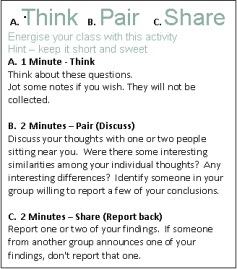This might be awkward. Let’s consider that painful moment (or two or infinity) between when we ask the class a discussion-launching or comprehension-checking question and when (a) we give up in despair of ever hearing a human voice again or (b) that nice kid in the front row finally offers something up out of plain desperation. We all know that good teaching involves getting our students to actively connect with the material, and the discussion prompt is a tried and true means of engagement. But we’ve all also experienced the blank stares, the down-turned heads, the aimless shuffling through notes that all say “I would rather die than form an out-loud sentence right now.”
For your consideration, I recommend some version of the Think-Pair-Share

technique for getting past the awkward silences to real discussion and improved learning. This is when you ask a question and give students a few minutes to think about their responses, then they discuss their ideas with a partner, and then each pair shares a response with the whole class. There are countless varieties of this popular method: Write-Pair-Share (students do a solo quick-write before discussing—gives you something to collect if desired); Think-Pair-Square-Share (students discuss in pairs, then in groups of four before sharing—shortens the reporting-out period in a large class); and of course there are a variety of tools for pairing and sharing, both synchronously and asynchronously, in online classes.
The benefits of this technique are many: Cautious students have a smaller, safer space to try out their ideas, confident students get practice in the skill of explanation, novice learners gain critical processing time, faculty get a window into students’ understanding, and we all are relieved of that soul-killing awkward silence.
But it turns out the key to the success of the Think-Pair-Share is in the details. For instance, the question has to be big and hard enough to generate real thought, but focused enough that students can get a handle on it. Projecting the question (and/or an image/graph/chart) is helpful. It’s also critical that students are given enough time to actually process the question and assemble their thoughts. Even if not every pair gets the opportunity to share, it’s probably more important to give adequate time to the thinking and pairing. Of course, it’s also vital to signal that what’s been shared actually matters—by revisiting a concept that has been shown to be tricky, by praising an insightful contribution, by connecting ideas across the groups.
Here’s a great 10-minute video explaining and demonstrating the Think-Pair-Share technique in an introductory Biology class at San Francisco State—relevant to any discipline.
* Authored by Dr. Katherine McCarthy.
